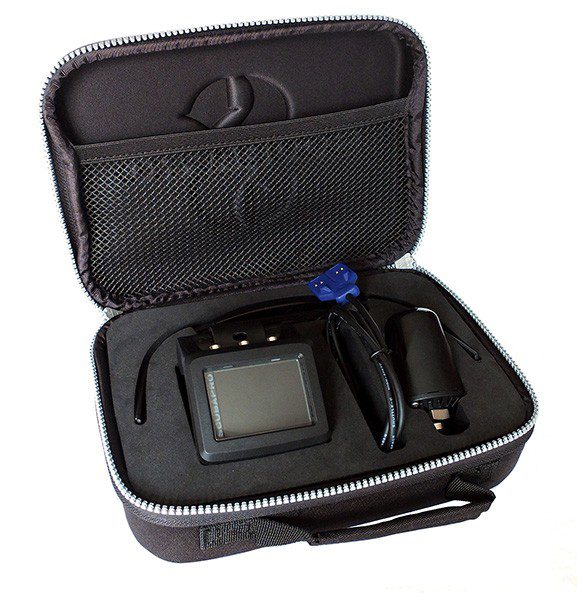DIVE COMPUTER
THE ORIGINAL: Scubapro Galileo Sol was the first dive-computer to integrate gas- consumption and workload, as measured by your heart-rate, into the decompression plan it provided. Now Scubapro has further developed the concept, and included a range of technical and practical improvements into the new G2.
On the technical front, the G2 uses the Buhlmann ZHL-16 ADT MB PMG algorithm, which models more tissue compartments than the ZHL-8 of the Sol, permits you to programme in more gases for use in your dive, supports rebreather and sidemount diving, has a rechargeable battery that doesn’t need you to open up the case to charge, and has a full-colour screen.
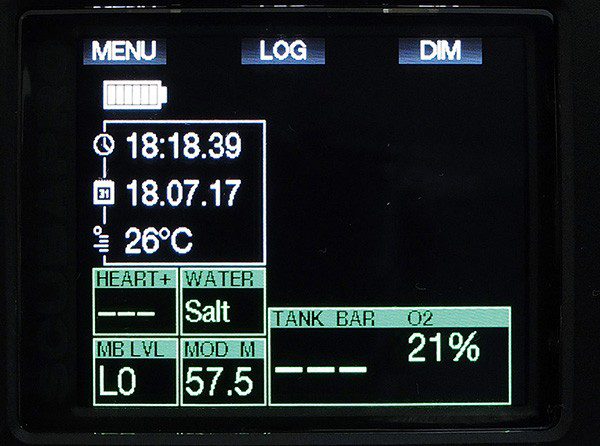
The G2 offers divers a single instrument that Scubapro says will develop with you, from recreational diving with a single cylinder of air to closed-circuit rebreather using trimix and multiple bail-out cylinders, without needing to buy extra software keys or dealer-enabled upgrades.
If that isn’t enough, the unit continues to feature gas-integration, gas-usage and heart-rate monitoring, temperature-monitoring and a digital compass among a list of features so long that it’s hard to know where to start a sensible review.
And yet Scubapro claims that the unit is so simple and intuitive to set up and use that you don’t need an instruction book, so it doesn’t supply one. There’s a get-you-started quick guide, but you’ll need to download the full instruction book from the Internet if you want it.
Getting Started
Without so much as a glance at the Quick Start guide, I unzipped the neatly fitted case and got stuck in.
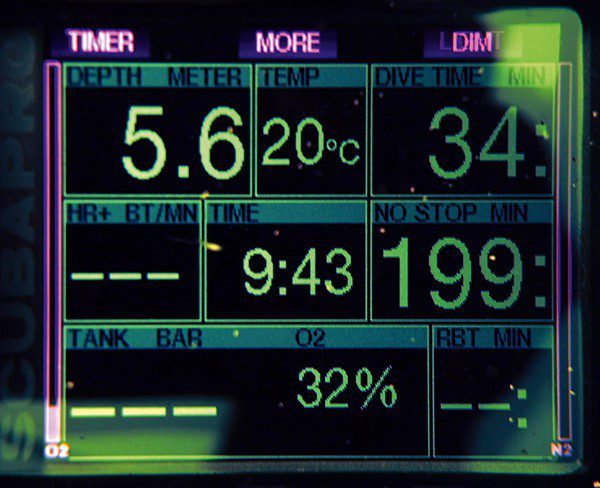
Scubapro had sent me the G2 with heart-rate monitor and a single pressure transmitter to attach to a first stage, plus the USB charger cable that also permits you to download dives.
This is the top kit in the G2 line. If you prefer, you can buy the computer on its own, computer plus transmitter, or the full set.
I lifted out the computer, removed the protective blue film from the display and pressed the three buttons above the screen one after the other. The right-hand button turned the unit on and I was asked to set up the language to display (English), the units to use (metric), and the time zone, which turned out to be different from setting the date and time. I found myself looking at a screen packed with information.
The surface display shows a variety of useful data and is easy to read. At the top of the screen the three buttons are labelled Menu, Log and Light (the right button might be labelled Dim if the light is already on, but you get the idea). I found that pressing each button does exactly what you’d expect it to do. There was no point pressing the Log button as the log was empty, but I gave it a go anyway.
The real action was in Menu, which is where you go to make changes and set up the computer, and the G2 stays user-friendly despite the range of things you can fiddle with. Sorry, I meant customise to match your preferences.
In fact, despite being so far below the technological event horizon that it’s still 1983 in my head, I managed to change, personalise, customise and generally set up the computer to monitor single-tank, multiple-tank, trimix and CCR dives in about 20 minutes from opening the case. If I can do it, so can you.
Say you want to dive on nitrox 32. Press the left of the three buttons to open the settings menu, use the left and middle buttons to scroll up or down until you get to “O2 Setting”, and press the right button to enter the sub-menu.

Use the left or middle buttons to adjust the oxygen fraction to 32%, and confirm the setting with a short press of the right button. A long press returns you to the surface screen, which will confirm the 32% setting and show you your maximum depth for that gas. The G2 assumes a maximum PO2 of 1.4 bar out of the box, but you can customise that if you feel the need.
It’s nearly as quick to do as it is to read, and though you will find yourself making a long press when you need a short one, and the other way round, you’ll work it out in no time.
Those buttons you’ve been pressing are very well thought-out. They’re big and far enough apart to press easily even with gloves on, and they need enough pressure over a reasonable length of travel to make them hard to press by accident, which is just what you need.
It sounds like a small thing, but it isn’t in real life when you’re depending on the instrument for your safe return to the surface, and it shows that the designers know what they’re about.
Gases & Integration
If you want to dive on trimix or with a rebreather the G2 remains your friend, though you’ll need to enable these in one menu and then turn them on in a different one, which is confusing and the one point where the intuitive thing isn’t so great – and where I had to admit defeat and download the full instruction book.
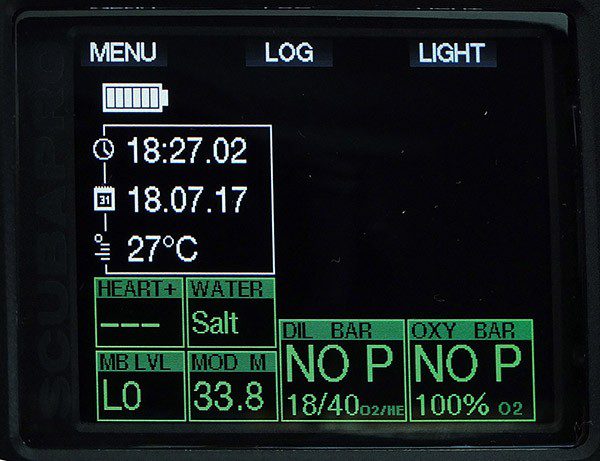
The G2 can be set to use as many as eight gases on a single dive. Why you’d consider more than three or four I’m not sure, but knock yourself out, it’s your dive.
Setting up the tank-pressure monitor is easy – just screw the transmitter into an appropriate port on your first stage, or get the dealer to do it, match the transmitter and computer so that they can talk to one another and you’re set.
Do that for each separate tank you carry and the G2 will allow you to monitor them all as you dive, and take your gas consumption and the water temperature into account when it calculates your deco.
At this point you’ll be relieved to hear that the display changes to a much simpler read-out under water, with nice big numbers for those of us who find our arms growing shorter as we age. It’s as intuitive to read as the unit is to set up.
If you’re using more than one gas, the G2 assumes that the gas with the lowest oxygen content will be the one with which you start the dive, and then prompts you to switch to other gases on ascent.
If you’re on a rebreather you’ll need to set shallow and deep setpoints and the G2 will assume that you start on the shallow setpoint, ask you to confirm the switch to the deep setpoint on descent, then confirm the switch back on ascent.
If you need to bail out, you switch gases using a combination of button-presses to select the appropriate bail-out gas for your current depth. Miss a switch, and the G2 will recalculate your deco on the fly using the other programmed gases.

That decompression programme has been developed with more than a nod to the latest thinking on the importance of microbubbles as a predictor of potential deco incidents, so the G2 allows you to set an additional personal safety margin by altering the micro-bubble setting, from level zero, L0, which has no additional padding, to level nine, L9, the most conservative setting. It will also add intermediate stops if it calculates them to be necessary, taking into account all the factors it can measure.
Other Features
Lawks, I haven’t yet mentioned the heart-rate monitor! This factors your heart rate into the decompression calculations as necessary to compensate for those times when you get all excited or a bit nervous. It fits around your chest on an elastic strap, and is depth-rated to 60m for use under a wetsuit.
Then there is the digital compass, which is bright and easy to follow, and works pretty well regardless of how you have the computer tilted.
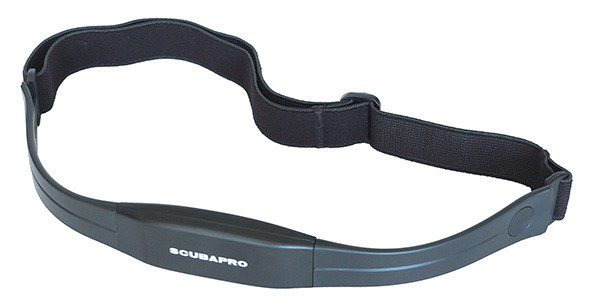
And there’s more, such as the option to put some personal medical information into the unit. If your day turns out badly, knowing your medical history might make all the difference.
The charging cable doesn’t require you to open a port on the computer, so you can’t leave the battery-compartment open and drown it. You can use the same cable to load pictures onto your computer to look at under water.
I know, that sounded gimmicky to me as well, but if you were to upload a plan of the dive-site or the wreck you could access it on the dive if you were a bit unsure of where you were.
What else? Lots of smart technical stuff, to tell the truth, but more down to earth are a clear protective film for the screen to prevent scratching, and the strap.
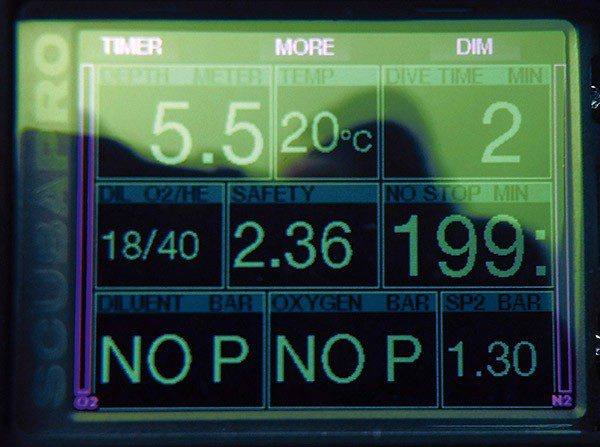
This is a chunky affair with a substantial buckle, but if you prefer you can remove it and use the lugs at each of the four corners to thread through some bungee cord instead.
I like both those lo-tec features – they’re a practical and thoughtful piece of design that shows that real divers have been involved in the development of the product.
All in all I’m minded of The Lord of the Rings and the bit about “One ring to rule them all”, except here it’s “One computer to suit them all”, and almost without an instruction book.
I’ve barely scratched the surface of what this computer can do. It is a hugely complex and capable piece of kit that’s been well designed and is as simple to use as Scubapro promises.
Specs
PRICES: Computer £665, with gas-pressure transmitter £829, with transmitter and heart-rate monitor £899
WEIGHT: 200g
COLOUR: Black
CONTACT: SCUBAPRO Website
DIVER GUIDE: 9/10
